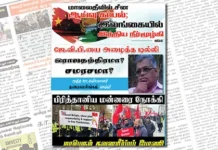Sri Lanka is bankrupt and restructuring its debts. But there’s a high risk that this restructuring will not be thorough enough, leaving the country with a festering problem that will probably just lead to another default.
And to a large extent, this is a result of the IMF’s bizarrely puny targets. The IMF argues that Sri Lanka’s debt will be sustainable if the country gets its public debt down to 95 per cent of GDP by 2032. From the March programme: B. Restoring Public Debt Sustainability 17. Sri Lanka’s public debt is assessed as unsustainable. The debt-to-GDP ratio is projected to have reached 128 per cent of GDP in 2022, due to exchange rate depreciation, the fiscal deficit, and negative real GDP growth. The authorities’ fiscal adjustment alone cannot reduce debt to sustainable levels. 18. The authorities are committed to restoring debt sustainability.
Their objectives are to:
- reduce the level of public debt below 95 per cent of GDP by 2032;
- (ii) reduce average central government gross financing needs (GFNs) in 2027—32, including from the materialization of contingent liabilities, below 13 per cent of GDP, so that rollover risks under stress are manageable;
- (iii) keep FX debt service of the central government below 4.5 per cent of GDP in any year during 2027-32; and
- (iv) ensure that the fiscal and external financing gaps are closed. Those are ridiculously unambitious target.
This basically means that Sri Lanka’s debts will be judged sustainable even if the burden tops its GDP over the next decade. Remember, this is a country that got into trouble with a pre-pandemic debt-to-GDP ratio below 80 per cent. In addition, there are no targets for the external debt stock — the IMF’s founders would be aghast.
The IMF’s new debt sustainability model focuses on “gross financing needs” instead of the net present value of Sri Lanka’s external debt. And the model seems to say that Sri Lanka’s debts are sustainable as long as it keeps gross financing needs below 13 per cent of GDP. There isn’t an explicit limit on the amount Sri Lanka can pay on its external debt, but the requirement that foreign-currency financing needs remains below 4.5 per cent of GDP functions like a limit on the amount of expected external debt servicing.
However, Sri Lanka’s basic problem has historically been its low ability to collect taxes. Revenues averaged just 11.5 per cent of GDP in the decade prior to Sri Lanka’s default — and dipped below 10 per cent of GDP after an ill-advised tax cut just before the pandemic. The IMF program now forecasts that revenue will rise to around 15 per cent of GDP — a skinny revenue base for such a country with public debts of over 100 per cent of GDP.
Let’s do some basic debt math. If you assume a 5 per cent average interest rate on Sri Lanka’s debt and a debt-to-GDP ratio around 100 per cent. the IMF’s revenue projections imply that Sri Lanka will spend about a third of its revenue on interest payments alone in years to come. Even this calculation is optimistic. In the low interest rate era of the past decade, Sri Lanka’s average debt costs hovered around 8 per cent.
Plugging this in the calculation above means more than half of Sri Lanka’s revenue would be gobbled up with interest payments. According to the IMF, only four countries for which data is available in 2023 will spend more than a third of their revenue on interest payments: Pakistan, Egypt, Ghana, and Malawi. Ghana and Malawi are already undergoing debt restructurings. Egypt and Pakistan are in IMF programs and arguably should bite the bullet and restructure their debts too. Additionally, none of these countries can access the international bond markets for meaningful sums.
Yet the IMF programme envisages that Sri Lanka will be back in the market in 2027. If the expected $1.5bn in bond market funding doesn’t materialise, Sri Lanka could face a significant drain on foreign reserves just as it loses access to its IMF lifeline. To be fair, Sri Lanka did sustain high interest payments as a share of revenue in the past.
 But its interest to revenue ratio of between 30 and 40 per cent was fundamentally a function of unusually low revenues — interest payments of 5.6 per cent of GDP and revenues of 12 per cent of GDP in 2019 for example. That was part of the reason why Sri Lanka couldn’t manage its debt through the shock of the pandemic.
But its interest to revenue ratio of between 30 and 40 per cent was fundamentally a function of unusually low revenues — interest payments of 5.6 per cent of GDP and revenues of 12 per cent of GDP in 2019 for example. That was part of the reason why Sri Lanka couldn’t manage its debt through the shock of the pandemic.
The IMF’s targets for Sri Lanka have an internal logic with the IMF’s frameworks, but they are fundamentally hard to square with the Fund’s targets for Zambia, which looks remarkably like Sri Lanka on many metrics underpinning debt service capacity. The two countries have similar levels of public debt-to-GDP and external debt-to-GDP, for example. If anything, Zambia looks stronger as it historically has had a larger export sector and collects about 20 per cent of GDP in revenue annually. But the IMF has set much more demanding targets for Zambia than Sri Lanka.
For example, a quick calculation shows that Zambia’s target for external debt service as a share of revenue is less than half the one the IMF set (indirectly) for Sri Lanka. Sri Lanka’s targets, in essence, are the result of threshold effects induced by the sharp difference between the IMF’s two models for assessing debt sustainability — the one for low-income countries, and the one for “market-access countries”. The lines between the models are blurred of course — a number of low-income countries in practice have had more market access than Sri Lanka (eg Ghana).
But it certainly seems like the supposedly state of the art market-access model isn’t doing a good job setting debt restructuring targets for lower middle-income countries with volatile revenue and export bases. There’s also a second issue with the market-access debt sustainability model: by focusing entirely on the stock of public debt and overall gross financing needs, the model creates an incentive to use domestic debt as a variable of adjustment.
At first, the Sri Lankan authorities had presented a restructuring plan that only encompassed external debt, which makes sense for a country that defaulted on its external debt because it had literally run out of reserves but continued to service its domestic debt. But following a demand by bondholders, Sri Lanka is now also undergoing a domestic debt “optimisation”.
From a July presentation to investors: However, this exercise seems driven by a need to reduce the contribution of domestic debt service to the gross financing needs rather than tackle any real vulnerability, instead enabling Sri Lanka to maximise debt service to foreign creditors within the IMF’s generous targets. Sri Lanka is not going to default because it can’t rollover bills held by the central bank: the domestic debt optimisation exercise addresses what in effect is non-existent vulnerability.
So what happens next? Well, the IMF isn’t going to change its targets. External creditors — be they the bondholders or China’s policy banks — certainly aren’t going to be pushing for any adjustments to the IMF’s targets. In fact, Sri Lanka’s Eurobonds rallied from a bottom in the low 20s in November 2022 as the IMF targets leaked into the market and are currently hovering around 45 cents on the dollar.
That puts the onus on Sri Lanka to insist that the IMF targets cannot be the baseline scenario and reach a deal that hacks down the stock of external debt and limits the future burden of servicing it. This is obviously easier said than done — most restructurings try to sweep in as much debt service as the IMF program allows.
And there’s one more twist: Sri Lanka wasn’t eligible for the G20’s Common Framework, and therefore isn’t negotiating with a single official creditors committee. China has refused to join the committee formed by India, Japan and France with most other official bilateral creditors. In fact, Sri Lanka is negotiating with many distinct external creditor groups — the official bilateral creditor committee organised by the Paris Club; China’s official creditors (basically China Eximbank); “private” Chinese state banks like ICBC and the China Development Bank (CDB); private bondholders; and other non-bonded debt holders like HSBC or Deutsche Bank. Chinese creditors don’t want to negotiate in a single forum with the Paris Club — and it sure seems like China Exim and CDB don’t want to negotiate together either.
Coordinating multiple comparable restructurings is always a challenge. However, Sri Lanka should insist on at least one thing: if creditors want anything close to the maximum allowed by the IMF program, they don’t need any more upside. Value-recovery instruments like GDP-linkers should be compensation for real debt relief, not a sweetener on top of an already too sweet deal.
The Paris Club creditors should set an example here and not insist on following the model of Zambia’s restructuring, which features a one-off state-contingent trigger that lets official creditors extract more debt service if the economy outperforms IMF forecasts. Going forward however, we draw three lessons from Sri Lanka:
— Complex models should not trump common sense: countries that dedicate more than a third of projected revenue to interest payment are not likely to be sustainable and regain market access.
— Separate program targets need to be set on external debt, notably on the stock. External debt is a claim on reserves and export proceeds
— and thus is fundamentally different from domestic debt.
— Setting targets for public debt instead of external debt will generate pressure for unnecessary domestic debt restructurings.
If the IMF thinks a domestic debt restructuring is necessary, as it was in Ghana, the program should be built around this domestic debt restructuring from the start.
The IMF and the World Bank are now reviewing the low-income country debt sustainability model. But it could well be more urgent to conduct a review of whether the market-access model — which was designed to be an indicator of building fiscal vulnerabilities — is producing appropriate targets for the restructuring of the external debt of middle-income countries experiencing balance of payments difficulties.
FT.com
Theo Maret is a research analyst at Global Sovereign Advisory and writes a sovereign debt newsletter. Brad Setser is a senior fellow at the Council on Foreign Relations and a former Treasury Department official.





